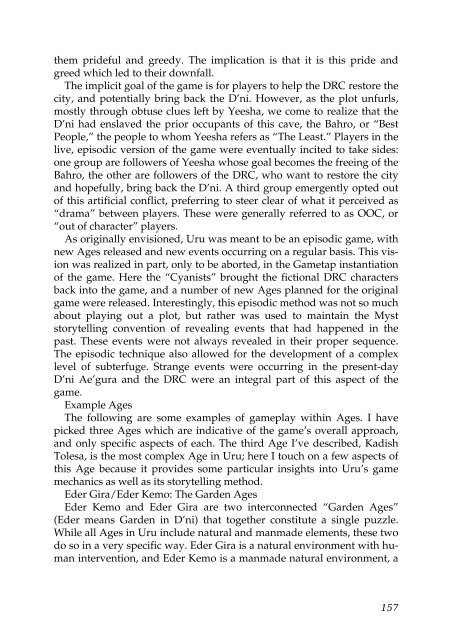Well Played 2.0: Video Games, Value and Meaning - OpenLibra
Well Played 2.0: Video Games, Value and Meaning - OpenLibra
Well Played 2.0: Video Games, Value and Meaning - OpenLibra
You also want an ePaper? Increase the reach of your titles
YUMPU automatically turns print PDFs into web optimized ePapers that Google loves.
them prideful <strong>and</strong> greedy. The implication is that it is this pride <strong>and</strong><br />
greed which led to their downfall.<br />
The implicit goal of the game is for players to help the DRC restore the<br />
city, <strong>and</strong> potentially bring back the D’ni. However, as the plot unfurls,<br />
mostly through obtuse clues left by Yeesha, we come to realize that the<br />
D’ni had enslaved the prior occupants of this cave, the Bahro, or “Best<br />
People,” the people to whom Yeesha refers as “The Least.” Players in the<br />
live, episodic version of the game were eventually incited to take sides:<br />
one group are followers of Yeesha whose goal becomes the freeing of the<br />
Bahro, the other are followers of the DRC, who want to restore the city<br />
<strong>and</strong> hopefully, bring back the D’ni. A third group emergently opted out<br />
of this artificial conflict, preferring to steer clear of what it perceived as<br />
“drama” between players. These were generally referred to as OOC, or<br />
“out of character” players.<br />
As originally envisioned, Uru was meant to be an episodic game, with<br />
new Ages released <strong>and</strong> new events occurring on a regular basis. This vision<br />
was realized in part, only to be aborted, in the Gametap instantiation<br />
of the game. Here the “Cyanists” brought the fictional DRC characters<br />
back into the game, <strong>and</strong> a number of new Ages planned for the original<br />
game were released. Interestingly, this episodic method was not so much<br />
about playing out a plot, but rather was used to maintain the Myst<br />
storytelling convention of revealing events that had happened in the<br />
past. These events were not always revealed in their proper sequence.<br />
The episodic technique also allowed for the development of a complex<br />
level of subterfuge. Strange events were occurring in the present-day<br />
D’ni Ae’gura <strong>and</strong> the DRC were an integral part of this aspect of the<br />
game.<br />
Example Ages<br />
The following are some examples of gameplay within Ages. I have<br />
picked three Ages which are indicative of the game’s overall approach,<br />
<strong>and</strong> only specific aspects of each. The third Age I’ve described, Kadish<br />
Tolesa, is the most complex Age in Uru; here I touch on a few aspects of<br />
this Age because it provides some particular insights into Uru’s game<br />
mechanics as well as its storytelling method.<br />
Eder Gira/Eder Kemo: The Garden Ages<br />
Eder Kemo <strong>and</strong> Eder Gira are two interconnected “Garden Ages”<br />
(Eder means Garden in D’ni) that together constitute a single puzzle.<br />
While all Ages in Uru include natural <strong>and</strong> manmade elements, these two<br />
do so in a very specific way. Eder Gira is a natural environment with human<br />
intervention, <strong>and</strong> Eder Kemo is a manmade natural environment, a<br />
157

















